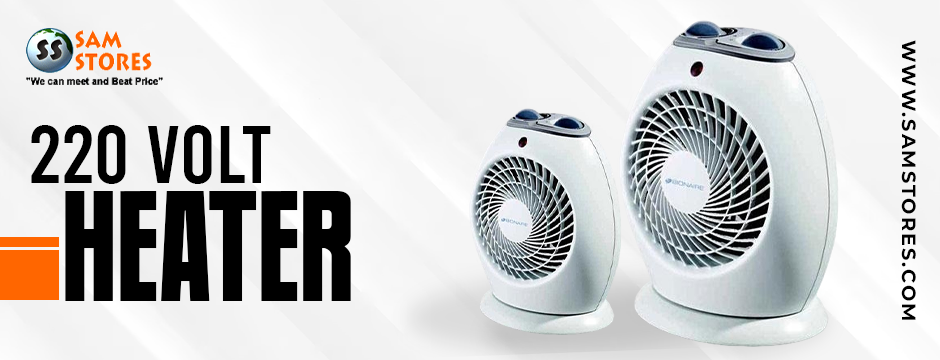Let’s be honest—when it comes to electric heaters, voltage can feel like one of those confusing technical details most people would rather ignore. And yet, somewhere along the way, a persistent myth snuck into public opinion: that a 220 volt heater
is “more efficient” than a 110V model.

At Sam Stores, we hear this almost daily from customers shopping for reliable heating. And we get it—on paper, 220V just sounds like it should be better, stronger, faster. But does it actually save you money on your electricity bill? Is it truly more energy-efficient?
Spoiler alert: Not exactly—but it’s not a pointless debate either.
Let’s unravel this together and help you make a decision that’s based on how heating really works, not just numbers on a box.
Where the Confusion Starts: Volts, Watts, and What Really Matters
Okay, let’s break this down without getting too “science-y.”
- Volts (V) = The pressure pushing electricity through your system.
- Watts (W) = The actual energy being used by your heater.
- Amps (A) = The amount of electric current flowing through the wires.
Now here’s the kicker: Energy consumption is based on watts, not volts.
So whether you plug in a 1500W heater that runs on 110V or one that runs on 220V, you’re still pulling the same amount of energy. Your electric bill doesn’t care about voltage—it cares about how many watts you’re using and for how long.
So why do so many people think 220V is more efficient?
The Truth: 220V Isn’t “More Efficient,” But It Does Have Advantages
Let’s say you’ve got two heaters—both rated at 1500W. One plugs into a standard 110V wall socket, and the other into a 220V outlet.
In terms of energy use? They’re exactly the same.
In terms of heat produced? Also the same.
But—and this is important—the 220V heater uses less current (amps) to do its job. That means:
- Less stress on your home’s wiring
- Lower risk of tripping breakers
- Ability to run larger heaters or multiple devices without overloading circuits
In short: The efficiency isn’t in how much energy it uses—but in how that energy is delivered.
That’s especially useful if you’re heating a large space like a garage, workshop, or basement where a 110V heater just doesn’t cut it.
More Power = More Heat Output (When You Need It)
Here’s where things get real.
Most portable 110V heaters max out at around 1500 watts. That’s enough for a small bedroom or office—but if you’re trying to heat 500+ square feet? You’ll be chilly for a while.
On the other hand, many 220 volt electric heaters are designed to output 3000W to 5000W or more. That’s twice or even triple the heat capacity, which means:
- Faster heating
- Better performance in colder environments
- Reliable comfort in bigger spaces
So while it’s not technically more efficient, the capability of a 220V system allows for stronger, more effective heating where it counts.
Installation: What You Need to Know Before You Buy
Here’s the part people often overlook—your home may not be ready for 220V.
Most U.S. outlets are 110V. Unless you’ve got a dedicated line for a dryer, oven, or A/C, you may need to bring in an electrician to install a 220V line.
So ask yourself:
- Are you okay with a bit of installation work?
- Are you heating a space permanently (garage, workshop)?
- Or do you want something plug-and-play?
110V heaters are perfect for quick fixes and rentals.
220V heaters are ideal for long-term use in large or drafty spaces.
At Sam Stores, we walk customers through this every day—no pressure, just clear advice so you know exactly what you’re getting into.
Circuit Efficiency vs. Energy Efficiency
Let’s talk about something most blogs won’t: electrical load.
While the energy usage of a 220V and 110V heater of the same wattage is the same, the way 220V systems work means they pull fewer amps. And that leads to:
- Less wear and tear on your electrical system
- More room on your panel for other devices
- Stable performance, even with other high-load appliances running
So if your space is already pushing the limits of your circuit breaker, a 220V setup can actually help things run more smoothly. It’s not about using less energy—it’s about using energy smarter.
Real Talk: Which One Is Right for You?
Here’s a simple cheat sheet based on the hundreds of customers we’ve helped at Sam Stores:
Go with a 110V Heater if:
- You’re heating a small room (bedroom, bathroom, office)
- You want portability and plug-and-play convenience
- You live in a rental and can’t modify wiring
Choose a 220V Heater if:
- You’re heating a garage, workshop, basement, or larger space
- You want faster and more powerful heating
- You already have a 220V line (or don’t mind installing one)
Final Thoughts from the Sam Stores Team
We get it—choosing between 110V and 220V heaters can feel overwhelming. But the real answer isn’t in voltage. It’s in what you need the heater to do.
- If you’re heating a small space for short bursts, a 110V heater is perfect.
- If you’re trying to make a large space livable in the dead of winter, go with 220V—you’ll thank yourself later.
And remember, our team at Sam Stores is always here to walk you through the process. Whether you’re new to electric heaters or upgrading from an old system, we’ll help you heat smarter—not harder.
Shop Smart. Stay Warm. Trust Sam Stores.
Explore our full range of 220 volt heaters, 220 volt infrared heaters, and plug-in electric units designed to keep your space warm without draining your wallet.